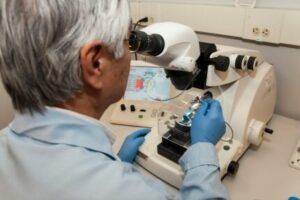Medically reviewed by Dr. Ramesh Gaddam, M.D. — Written by Sumalatha, D.N.H.E
2. Symptoms
The symptoms of cervical spondylosis can vary depending on the severity of the condition and individual factors, but common symptoms may include:

1. Neck Pain and Stiffness:
Persistent pain in the neck is a common symptom of cervical spondylosis.
Stiffness in the neck may make it difficult to move the head and neck comfortably.
2. Radiating Pain:
Pain may radiate from the neck to the shoulders and down the arms.
This pain can vary in intensity and may be accompanied by tingling or numbness.
3. Headaches:
Some individuals with cervical spondylosis experience headaches, often located at the back of the head.
These headaches may be associated with muscle tension or nerve compression.
4. Weakness and Numbness:
Compression of spinal nerves can lead to weakness in the arms, hands, and fingers.
Numbness or tingling sensations may also be felt in the affected areas.
5. Difficulty in Coordination:
In severe cases where the spinal cord is affected, individuals may experience difficulty with coordination and balance.
This can manifest as clumsiness or a feeling of unsteadiness.
6. Reduced Range of Motion:
Cervical spondylosis can result in a decreased range of motion in the neck.
Turning the head or tilting it from side to side may be limited or cause discomfort.
7. Muscle Spasms:
Chronic irritation of the muscles and nerves in the neck can lead to muscle spasms.
These spasms may contribute to pain and further restrict movement.
8. Pain Aggravated by Certain Activities:
Symptoms may worsen during activities that involve prolonged neck positions or repetitive movements.
Reading, working on a computer, or driving for extended periods may exacerbate pain.
9. Pain Relief with Rest or Change in Position:
Some individuals may find relief from cervical spondylosis symptoms by resting or changing their neck position.
Altering posture or using supportive pillows may alleviate discomfort.
10. Occasional Dizziness:
Compression of blood vessels in the neck or irritation of nerves can occasionally lead to dizziness.
This symptom may be more prominent with certain head movements.
3. Diagnosis
The diagnosis of cervical spondylosis typically involves a combination of medical history, physical examination, and imaging studies.
Here is an overview of the diagnostic process:

1. Medical History:
The healthcare provider will gather information about the patient’s symptoms, including the nature and duration of neck pain, any radiation of pain, and other associated symptoms such as weakness or numbness in the arms.
2. Physical Examination:
A thorough physical examination will be conducted to assess neck mobility, muscle strength, reflexes, and sensory function in the arms and hands.
The healthcare provider may also check for signs of spinal cord or nerve root compression, such as muscle atrophy or changes in reflexes.
3. Neurological Examination:
A neurological examination may be performed to evaluate nerve function, coordination, and reflexes.
This helps assess the extent of any nerve compression or spinal cord involvement.
4. X-rays:
X-rays can provide detailed images of the bones in the neck and can help identify abnormalities such as bone spurs, narrowing of the spinal canal, or misalignment of vertebrae.
5. CT Scan (Computed Tomography):
This imaging technique can provide more detailed images of the bones and may be used to assess the degree of spinal canal narrowing or the presence of herniated discs.
6. MRI (Magnetic Resonance Imaging):
MRI is effective in visualizing soft tissues such as discs, nerves, and the spinal cord.
It can help identify herniated discs, nerve compression, and other soft tissue abnormalities.
7. Myelography:
In some cases, a contrast dye may be injected into the spinal canal before imaging (myelogram) to provide a clearer view of the spinal cord and nerves.
8. Electromyography (EMG) and Nerve Conduction Studies:
EMG measures the electrical activity of muscles and can help identify nerve compression or damage.
Nerve conduction studies assess how well electrical signals travel along nerves, helping to diagnose nerve disorders.
9. Blood Tests:
While not commonly used for the diagnosis of cervical spondylosis, blood tests may be performed to rule out other medical conditions that could be contributing to symptoms.
10. Review of Symptoms and Functional Impact:
The healthcare provider will discuss the impact of symptoms on daily activities, quality of life, and overall function.
11. Consultation with Specialists:
In some cases, a referral to a neurologist or orthopedic specialist may be recommended for further evaluation or to discuss potential treatment options.
12. Differential Diagnosis:
Cervical spondylosis symptoms may overlap with other conditions such as cervical disc herniation, cervical radiculopathy, or other degenerative spine conditions.
The diagnostic process aims to distinguish between these conditions.
Once a diagnosis is confirmed, the healthcare provider can develop an appropriate treatment plan based on the severity of symptoms and the impact on the individual’s daily life.
5. Treatment
The treatment of cervical spondylosis aims to alleviate symptoms, improve neck function, and prevent further progression of the condition.

The specific treatment plan will depend on the severity of symptoms, the impact on daily life, and individual factors.
Medications:
Nonsteroidal anti-inflammatory drugs (NSAIDs) to reduce pain and inflammation.
Muscle relaxants to alleviate muscle spasms. Pain relievers such as acetaminophen.
Physical Therapy:
Exercise programs to improve strength, flexibility, and posture. Manual therapy techniques to reduce pain and improve mobility. Neck stretches and exercises prescribed by a physical therapist.
Heat/Cold Therapy:
Application of heat or cold packs to the affected area for pain relief.
Posture Correction:
Emphasize good posture during daily activities, especially while sitting and working.
Use ergonomic furniture and accessories to support proper posture.
Neck Exercises:
Specific exercises to strengthen neck muscles and improve range of motion.
Incorporate neck stretches into daily routines.
Cervical Collars:
Short-term use of a soft cervical collar may provide support and restrict movement to allow healing.
Prolonged use is generally not recommended as it can lead to muscle weakness.
Pain Injections:
Corticosteroid injections into the affected area for temporary relief of inflammation and pain.
Injections may be guided by imaging, such as fluoroscopy or ultrasound.
- Pain relievers, such as acetaminophen, for mild to moderate pain.
- Oral steroids may be prescribed for a short duration to reduce inflammation.
- Prescription muscle relaxants to alleviate muscle spasms.
Activity Modification:
Temporary modification or avoidance of activities that worsen symptoms.
Avoiding prolonged positions that strain the neck, such as looking down at a smartphone for extended periods.
Surgery:
Surgical intervention is considered in cases where conservative measures are ineffective, and symptoms are severe or progressive.
Common surgical procedures include discectomy (removal of a portion of a disc), cervical fusion, or artificial disc replacement.
Neck Traction:
Traction involves the application of force to stretch the spine, which may help relieve pressure on compressed discs and nerves.
This may be done manually or using devices.
Acupuncture and Massage:
Some individuals find relief from symptoms through complementary therapies such as acupuncture or therapeutic massage.
Summary:
It’s crucial for individuals experiencing symptoms of cervical spondylosis to work closely with their healthcare providers to determine the most appropriate and effective treatment plan for their specific situation.
The choice of treatment will depend on the severity of symptoms, the presence of complications, and individual factors such as overall health and lifestyle.
6. Cervical Spondylosis Exercises
Exercises play a crucial role in managing cervical spondylosis by helping to strengthen the neck muscles, improve flexibility, and maintain proper posture.

However, it’s essential to approach exercises with caution and perform them under the guidance of a healthcare professional or physical therapist, especially if you are experiencing severe pain or other complications.
Here are some general neck exercises that are commonly recommended for individuals with cervical spondylosis:
1. Neck Tilt:
Sit or stand with your spine straight. Slowly lower your chin towards your chest, feeling a stretch in the back of your neck. Hold for 5-10 seconds.
Return to the starting position.
2. Neck Turn:
Sit or stand with your spine straight. Turn your head to one side, bringing your chin over your shoulder. Hold for 5-10 seconds. Repeat on the other side.
3. Neck Flexion and Extension:
Sit or stand with your spine straight. Slowly tilt your head backward, looking towards the ceiling. Hold for 5-10 seconds. Return to the neutral position.
Slowly tilt your head forward, bringing your chin towards your chest. Hold for 5-10 seconds. Return to the neutral position.
4. Neck Lateral Flexion:
Sit or stand with your spine straight. Tilt your head to one side, bringing your ear towards your shoulder. Hold for 5-10 seconds. Repeat on the other side.
5. Shoulder Blade Squeeze:
Sit or stand with your spine straight. Squeeze your shoulder blades together, as if trying to hold a pencil between them. Hold for 5-10 seconds. Relax and repeat.
6. Chin Tucks:
Sit or stand with your spine straight. Gently tuck your chin towards your chest, as if creating a “double chin.” Hold for a few seconds. Repeat several times.
7. Resistance Exercises:
With your hand against your forehead, try to push your head forward while resisting with your neck muscles.
Place your hand against the side of your head and attempt to tilt your head sideways while resisting with your neck muscles.
Use resistance in various directions to strengthen different neck muscles.
8. Scapular Retraction:
Sit or stand with your spine straight. Squeeze your shoulder blades together without shrugging your shoulders. Hold for a few seconds. Relax and repeat.
Tips for Safe Exercise:
Start with gentle movements and progress gradually. Avoid sudden or jerky motions.
Perform exercises in a pain-free range of motion. Stop any exercise that causes increased pain or discomfort.
Consult with a healthcare professional or physical therapist before starting a new exercise program.
Summary:
Individual responses to exercises can vary, and what works for one person may not work for another. It’s crucial to customize exercises based on your specific symptoms and limitations.
If you experience persistent or worsening symptoms, consult with your healthcare provider for personalized guidance.
Frequently Asked Questions (FAQs)
What is the main cause of cervical spondylosis?
The main cause of cervical spondylosis is the natural aging process, which leads to the gradual wear and tear of the bones and discs in the neck. Over time, the discs lose their cushioning ability, and the bones may develop arthritis.
Can cervical spondylitis be cured?
Cervical spondylitis cannot be fully cured, but its symptoms can be managed with various treatments. The goal is to alleviate pain, improve function, and prevent further deterioration.
What are the worst symptoms of cervical spondylosis?
The worst symptoms of cervical spondylosis can include severe neck pain, stiffness, headaches, and radiating pain or numbness in the arms and hands.
Does cervical spondylosis go away?
Cervical spondylosis does not typically go away completely. It is a chronic condition that may improve with treatment but often requires ongoing management to control symptoms.
Is walking good for spondylosis?
Yes, walking is generally good for spondylosis as it helps maintain mobility and overall spine health. It is a low-impact exercise that can reduce stiffness and improve circulation.
How to sleep with cervical spondylosis?
To sleep comfortably with cervical spondylosis, use a supportive pillow that maintains proper neck alignment and try sleeping on your back or side rather than on your stomach.
What is the best treatment for cervical spondylosis at home?
The best home treatments for cervical spondylosis include applying heat or cold packs, practicing neck stretches and strengthening exercises, and maintaining good posture.
What is the best exercise for cervical spondylosis?
Gentle neck stretches and strengthening exercises, such as neck tilts and shoulder rolls, are beneficial for managing cervical spondylosis. These exercises help improve flexibility and reduce pain.
Why is spondylosis worse at night?
Spondylosis may worsen at night due to prolonged periods of inactivity, poor sleep posture, or the natural tendency of symptoms to intensify when the body is at rest.
What to avoid in cervical spondylosis?
Avoid activities that strain the neck, such as heavy lifting or sudden, jerky movements. Also, be cautious with poor posture and prolonged periods of sitting or standing.
Does drinking water help with spondylosis?
Drinking plenty of water helps keep the discs in the spine hydrated, which can be beneficial for overall spinal health and may alleviate some symptoms of spondylosis.
What is the best treatment for spondylitis?
The best treatment for spondylitis typically includes a combination of medications, physical therapy, and lifestyle changes to manage pain and inflammation.
Which vitamin is good for spondylitis?
Vitamin D is beneficial for spondylitis as it supports bone health and may help reduce inflammation. Adequate vitamin D levels are important for managing spondylitis symptoms.
What is the best food for spondylitis?
Anti-inflammatory foods, such as fatty fish, leafy greens, nuts, and berries, are good for spondylitis. These foods can help reduce inflammation and support overall joint health.
Which is the best tablet for spondylitis?
The best tablet for spondylitis varies depending on individual needs. Commonly prescribed medications include nonsteroidal anti-inflammatory drugs (NSAIDs) and disease-modifying antirheumatic drugs (DMARDs).
Which fruit is best for spondylosis?
Fruits rich in antioxidants and anti-inflammatory properties, such as berries, oranges, and apples, are beneficial for managing spondylosis and supporting overall health.
Can walking cure spondylitis?
Walking cannot cure spondylitis, but it can help manage symptoms by improving mobility, reducing stiffness, and supporting overall spine health.
How I cured my spondylitis naturally?
Curing spondylitis naturally is challenging, but many people find relief through a combination of lifestyle changes, such as regular exercise, a balanced diet, and stress management techniques.
What is the best exercise for spondylitis?
For spondylitis, exercises that focus on stretching and strengthening the spine, such as yoga and Pilates, can be beneficial. These exercises help maintain flexibility and reduce stiffness.
What is the root cause of spondylitis?
The root cause of spondylitis is often related to autoimmune factors where the body’s immune system attacks the spinal joints, leading to inflammation and pain. Genetics also play a role in susceptibility.
What is the best medicine for cervical spondylitis?
The best medicine for cervical spondylitis depends on the severity of symptoms. Common treatments include NSAIDs for pain and inflammation, and in some cases, muscle relaxants or corticosteroids.
Also Read:
Degenerative Disc Disease: Causes, Signs, 10 Things to Avoid
Medically reviewed by Dr. Ramesh Gaddam, M.D.

General Physician, Diabetologist, and Critical Care Specialist.
Discover more from Health Build-Up
Subscribe to get the latest posts sent to your email.


Pingback: Degenerative Disc Disease: Causes, Signs, 10 Things to Avoid
Pingback: 5 Newest Treatments for Spinal Stenosis (2024)